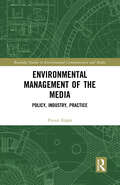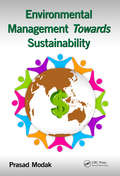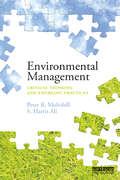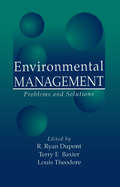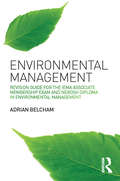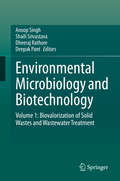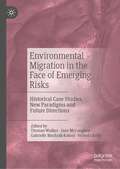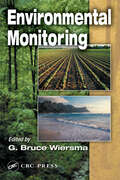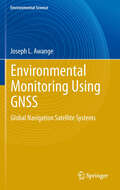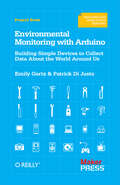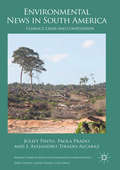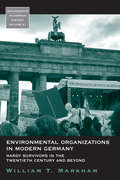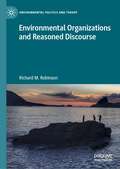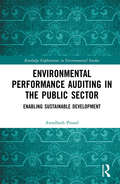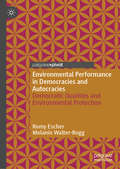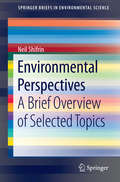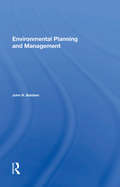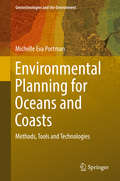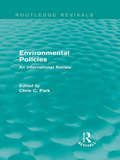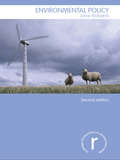- Table View
- List View
Environmental Management of the Media: Policy, Industry, Practice (Routledge Studies in Environmental Communication and Media)
by Pietari KääpäIn recent years the widely held misconception of the media as an ‘ephemeral’ industry has been challenged by research on the industry’s significant material footprint. Despite this material turn, no systematic study of this sector has been conducted in ways that considers the role of the media industries as consumers and users of a range of natural resources. Filling this gap, Environmental Management of the Media discusses the environmental management of the media industries in the UK and the Nordic countries. These Nordic countries, both as a set of small nations and as a regional constellation, are frequently perceived as some of the ‘greenest’ in the world, yet, not only is the footprint of the media industries practically ignored in academic research, but the very real stakes of the industries’ global impact are not comprehensively understood. Here, the author focuses on four key areas for investigating the material impact of Nordic media: (1) resources used for production and dissemination; (2) regulation of the media; (3) organizational management; and (4) labour practices. By adopting an interdisciplinary perspective that combines ecocritical analysis with interrogation of the political economy of the creative industries, Kääpä argues that taking the industries to task on their environmental footprint is a multilevel resource and organizational management issue that must be addressed more effectively in contemporary media studies. This book will be of great interest to students and scholars of media, communication and environmental studies.
Environmental Management towards Sustainability
by Prasad ModakThis book is about understanding challenges in managing our environment and ensuring sustainability of this planet. It presents the critical state of our resources and threats to resource security due to overconsumption, pollution and poor and uneven governance. Role of key stakeholders such as the Government, Financing Institutions, Business and Communities is important. These stakeholders need to collaborate at multiple levels – viz. Local, Regional, National and Global. Chapters are devoted to describing the role of the above stakeholders with numerous case studies. The book can serve as a textbook to academia, a reference for policy makers and planners and a resource for conducting continuing education programs for the professionals to introduce both the concepts and practice experience on sustainability.
Environmental Management: Critical thinking and emerging practices
by S. Harris Ali Peter R. MulvihillThe field of Environmental Management (EM) involves a broad and evolving repertoire of practices. The field originated around 1970 in response to new policy, regulation and public concern about environmental issues. EM has undergone many changes and improvements since then, progressing from a reactive, compliance-based focus toward, in leading cases, practices reflecting strong commitment to sustainability. And yet, EM remains, for the most part, ill-equipped to deal with the complex and highly uncertain implications of the ecological crisis. Environmental Management offers a rigorous critique of conventional EM and explores alternative ideas, frameworks and approaches that are currently considered "fringe", but which have the potential to transform the practice of EM. This book goes beyond narrow definitions and considers questions regarding the purpose, roles, scope and potential of environmental management. EM is situated and contextualized within the evolving and expanding realm of environment and sustainability literature. The book argues that new approaches to EM need to be more flexible, imaginative and better equipped to address future environmental problems of a scale and severity previously unforeseen. This book will be of great interest to students and scholars of environmental management, environmental planning, resource management, and environmental assessment.
Environmental Management: Environmental Issues, Awareness and Abatement
by Basharat Mushtaq Suhaib A. Bandh Sana ShafiIn the current age of science and technology, our lives have become dominated by countless scientific and technological innovations without which the earth would be a much poorer place. Life as we know would become absolutely bleak and boring without the inventions and advances being made all over the globe. In fact, scientific inventions, discoveries and innovations have ushered in a dramatic revolution in virtually every sphere of life. But at the same time, the skewed use of technology is at loggerheads with the environment. We, and our environment, now face a number of critical challenges and it is in response to this that we wrote this book to raise awareness for environmental issues and related management aspects. With a primary focus on Environmental Management – the rational reconciliation of man and nature, which involves the judicious exploitation and utilization of natural resources without disturbing the ecosystem’s balance – it will thus help to improve the relationship between man and environment. Moreover, it offers a wealth of ready-to-use material for advanced undergraduate and graduate students of Environment and Water Management. The book systematically addresses a range of key aspects, e.g. scientific principles, methods and ideas, as well as life-long learning skills for students. Further, it provides a solid foundation for applying scientific approaches to environmental problems.
Environmental Management: Problems and Solutions
by Louis Theodore R. Ryan Dupont Terry E. BaxterThere is a growing need to support undergraduate educators in the development of environmental management educational materials. Recognizing this need, the National Science Foundation funded a College Faculty Workshop on Environmental Management, that was conducted at Utah State University in July and August 1996. The principle objectives of the seminar were (1) to provide a meaningful course which would generate new ideas and innovative educational approaches in the emerging field of environmental management, and (2) to develop an applications-oriented problem workbook which would support undergraduate faculty involvement in the production of course materials. The result of this effort is Environmental Management: Problems and Solutions, an informative text on the essentials of environmental management.More than 200 structured problems presented in the book are meant to elicit a sound understanding of the basics of environmental monitoring, assessment and control. Detailed solutions to each problem, provided with each chapter, will prove useful to both the student and the instructor.This innovative text is a valuable resource for anyone involved in training of engineers and scientists in the field of environmental engineering.
Environmental Management: Revision Guide for the IEMA Associate Membership Exam and NEBOSH Diploma in Environmental Management
by Adrian BelchamWritten by Adrian Belcham, author of Manual of Environmental Management, this is the essential guide to prepare you for the IEMA Associate Membership Exam and NEBOSH Diploma in Environmental Management. Through the inclusion of revision tips, exam guidance and self-test questions, this guide will consolidate your understanding of environmental management and help you to prepare for your exam. It provides full coverage for both the IEMA and NEBOSH exams and includes coloured sections to help you to identify the content relevant for each qualification. Small, handy size ideal for on the move Illustrations and tables to improve understanding Written by expert tutor of IEMA and NEBOSH environmental qualifications.
Environmental Markets
by Terry L. Anderson Gary D. LibecapEnvironmental Markets explains the prospects of using markets to improve environmental quality and resource conservation. No other book focuses on a property rights approach using environmental markets to solve environmental problems. This book compares standard approaches to these problems using governmental management, regulation, taxation, and subsidization with a market-based property rights approach. This approach is applied to land, water, wildlife, fisheries, and air and is compared to governmental solutions. The book concludes by discussing tougher environmental problems such as ocean fisheries and the global atmosphere, emphasizing that neither governmental nor market solutions are a panacea.
Environmental Mediation: An International Survey (Routledge Research in International Environmental Law)
by Catherine Choquette Véronique FraserEnvironmental mediation continues to develop and evolve in different jurisdictions across the world in order to prevent potential environmental conflicts or to resolve the conflicts while avoiding the inherent drawbacks of an adjudicated solution. This book takes a comparative approach to explore the legal framework of environmental mediation with a focus on the judicial, administrative and private procedures and the criteria for accrediting mediators in a range of jurisdictions across the world. It also examines practical considerations for environmental mediators while analysing the effectiveness of different mediation processes.
Environmental Microbiology and Biotechnology: Volume 1: Biovalorization of Solid Wastes and Wastewater Treatment
by Anoop Singh Dheeraj Rathore Deepak Pant Shaili SrivastavaThis book provides up-to-date information on the state of the art in applications of biotechnological and microbiological tools for protecting the environment. Written by leading international experts, it discusses potential applications of biotechnological and microbiological techniques in solid waste management, wastewater treatment, agriculture, energy and environmental health. This first volume of the book “Environmental Microbiology and Biotechnology,” covers three main topics: Solid waste management, Agriculture utilization and Water treatment technology, exploring the latest developments from around the globe regarding applications of biotechnology and microbiology for converting wastes into valuable products and at the same time reducing the environmental pollution resulting from disposal. Wherever possible it also includes real-world examples. Further, it offers advice on which procedures should be followed to achieve satisfactory results, and provides insights that will promote the transition to the sustainable utilization of various waste products.
Environmental Migration in the Face of Emerging Risks: Historical Case Studies, New Paradigms and Future Directions
by Thomas Walker Victoria Kelly Jane McGaughey Gabrielle Machnik-KekesiThis book will provide a space for new and emergent research in environmental migration, particularly in the context of a world beginning to emerge from the grip of a debilitating public health crisis that kept many firmly rooted in place while displacing others internationally. With famines, vast wildfires, droughts, and record heatwaves uprooting human settlements internationally, research on migration in the face of emerging risks is all the more urgent. As Balsari, Dresser, & Leaning point out, “the wall-building, xenophobic, and insular” platforms of some global powers in their immigration and asylum policies, and the ever-increasing stresses placed on the natural world that continue to make sites of human settlement less and less hospitable, make research on this topic both very timely and much needed. This book will include numerous case studies, historical analyses, projections, models, and recommendations for both policy and future research directions. Contributions are drawn from academics and practitioners in this fertile interdisciplinary field of academic inquiry, and each one focuses on the intersection of population and environment studies, history, geography, law, diaspora studies, economics, public health, and sociology.This book is composed of five clear sections. The introductory section includes one chapter that presents an overview of the current landscape, the scope and objectives of the book, as well as its specific approach and the various themes. The concluding section is composed of one chapter that presents a global map of recent innovations drawing together some of the core themes discussed throughout the book. The concluding chapter synthesizes the challenges and opportunities presented, and the possible future directions that researchers, practitioners, and regulators could and should move towards.
Environmental Monitoring
by G. Bruce WiersmaThe current rate and scale of environmental change around the world makes the detection and understanding of these changes increasingly urgent. Subsequently, government legislation is focusing on measurable results of environmental programs, requiring researchers to employ effective and efficient methods for acquiring high-quality data. Focusing on pollution issues and impacts resulting from human activities, Environmental Monitoring is the first to bring together the conceptual basis behind the complex and specific approaches to the monitoring of air, water, and land. Coverage includes integrated monitoring at the landscape level, as well as case studies of existing monitoring programs such as the Chesapeake Bay Program. The book also addresses the recent legislative focus on high-quality data results and conducting monitoring programs in different ecosystems and environmental media.
Environmental Monitoring using GNSS
by Joseph L. AwangeGlobal Navigation Satellite Systems (GNSS) are revolutionizing the world in a way their original developers never envisaged. From being military "war" tools, GNSS satellites are rapidly becoming "peace" tools that play a potentially critical role in enabling changing environmental phenomenon that do not permit direct measurements to be remotely observed via their all-weather, highly accurate and continuously updatable positional time series. This is evident, for example, in their use in emerging environmental monitoring methods that are considered in this book. These include: GPS-based radio telemetry, which is enhancing ecological and conservation monitoring by more accurately mapping animal movements, their behaviours, and their impact on the environment; GNSS-meteorology, which is contributing to weather and climate change studies; GNSS-remote sensing, which, for example, allows the rapid monitoring of changes in fresh water resources and cryosphere; Geosensor network techniques, which are earning a crucial role in disaster response management; Epidemiology, for improved efficiency in tracking and studying the spread of infectious diseases and climate change effects on vector-borne diseases; and Economics, to provide data for the econometric modelling of casual impact of policies. In Environmental Impact Assessments (EIA), Strategic Environmental Assessments (SEA), and Sustainability Assessments (SA), GNSS, together with other spaced-based remote sensing techniques, are emerging, not only as modern tools that connect the developers to the community, but also provide information that support Multi-Criteria Analysis (MCA) methods, which inform decision making and policy formulations. By bringing the two fields of geodesy (the parent of GNSS technology) and environmental studies (potential users of this technology), this book presents the concepts of GNSS in a simplified way that can, on the one hand, be understood and utilised by environmentalists, while on the other, outlines its potential applications to environmental monitoring and management for those engaged more with its technology, which hopefully will further energise the already innovative research that is being carried out. Lastly, this book is most relevant to all the professionals whose work is related to the environment such as hydrologists, meteorologists, epidemiologists, economist, and engineers, to name just a few.A comprehensive yet candid and compelling presentation of Global Navigation Satellite Systems and its application to environmental monitoring and a host of other socio-economic activities. This is an essential and new ground breaking reading for all professional practitioners and even academics seeking to study and become involved in using Global Navigation Satellite Systems in diverse fields ranging from environmental monitoring to economic activities such as monitoring weather and climate in order to design crop failure insurance. Nathaniel O. Agola, Professor of Business and Financial Economics, Ritsumeikan University, Japan
Environmental Monitoring with Arduino: Building Simple Devices to Collect Data About the World Around Us
by Emily Gertz Patrick Di JustoAfter the devastating tsunami in 2011, DYIers in Japan built their own devices to detect radiation levels, then posted their finding on the Internet. Right now, thousands of people worldwide are tracking environmental conditions with monitoring devices they’ve built themselves. You can do it too!This inspiring guide shows you how to use Arduino to create gadgets for measuring noise, weather, electromagnetic interference (EMI), water purity, and more. You’ll also learn how to collect and share your own data, and you can experiment by creating your own variations of the gadgets covered in the book. If you’re new to DIY electronics, the first chapter offers a primer on electronic circuits and Arduino programming.Use a special microphone and amplifier to build a reliable noise monitorCreate a gadget to detect energy vampires: devices that use electricity when they’re “off”Examine water purity with a water conductivity deviceMeasure weather basics such as temperature, humidity, and dew pointBuild your own Geiger counter to gauge background radiationExtend Arduino with an Ethernet shield—and put your data on the InternetShare your weather and radiation data online through Pachube
Environmental News in South America
by Juliet Pinto Paola Prado J. Alejandro Tirado-AlcarazCombining perspectives from media studies and political ecology, this book analyses socially constructed news regarding three environmental conflicts in South America. In recent decades, South American political administrations have tied national economies to neo-extractive development strategies, creating not only vulnerabilities to global commodity boom and bust pricing cycles, but also to conflict regarding environmental and cultural degradation from extraction activities. Environmental contestations among indigenous peoples, environmental and social NGOs, state actors, and extraction industries receive media attention, but how these disputes are covered has implications for understandings of media performance in democratizing nations. The authors examine three case studies of environmental contestation in a region that is simultaneously vulnerable to the effects of climate change, and yet has become once again dependent on commodity exportation to industrializing and industrialized nations for economic benefit and social development strategies.
Environmental Organizations In Modern Germany: Hardy Survivors in the Twentieth Century and Beyond (Monographs in German History #21)
by William T. MarkhamGerman environmental organizations have doggedly pursued environmental protection through difficult times: hyperinflation and war, National Socialist rule, postwar devastation, state socialism in the GDR, and confrontation with the authorities during the 1970s and 1980s. The author recounts the fascinating and sometimes dramatic story of these organizations from their origins at the end of the nineteenth century to the present, not only describing how they reacted to powerful social movements, including the homeland protection and socialist movements in the early years of the twentieth century, the Nazi movement, and the anti-nuclear and new social movements of the 1970s and 1980s, but also examining strategies for survival in periods like the current one, when environmental concerns are not at the top of the national agenda. Previous analyses of environmental organizations have almost invariably viewed them as parts of larger social structures, that is, as components of social movements, as interest groups within a political system, or as contributors to civil society. This book, by contrast, starts from the premise that through the use of theories developed specifically to analyze the behavior of organizations and NGOs we can gain additional insight into why environmental organizations behave as they do.
Environmental Organizations and Reasoned Discourse (Environmental Politics and Theory)
by Richard M. RobinsonThis book explores the meaning and role of “fair and reasoned discourse” in the context of our institutions for environmental decision processes. The book reviews the roles of our “environmental advocacy organizations”—such as The Sierra Club, The Audubon Society, the Environmental Defense Fund—in providing and ensuring that our discourse and decisions are fair and reasoned according to the criteria of being (i) inclusive of input from all affected, (ii) informed of relevant scientific and socio-economic information, (iii) uncorrupted by direct conflicts of interest, and (iv) logical according robust review by uncorrupted judges. These organizations are described and examined as expressions of “collective imperfect duty,” i.e. the coordinated duties with environmental direction. The current state of our discourse is examined in light of this fairness criteria, particularly in consideration of the cross-border problems that threaten tragedies of the global commons.
Environmental Performance Auditing in the Public Sector: Enabling Sustainable Development (Routledge Explorations in Environmental Studies)
by Awadhesh PrasadEnvironment and sustainable development challenges are a matter of global concern. Trillions of dollars of mostly public money are invested every year in domestic and international policies and programs to address these challenges. The effectiveness of these policies and programs is critical to environmental sustainability. Performance audits that examine the effectiveness of governmental policies and programs heavily influence their implementation. Despite this, performance auditing in the environment field has received very little academic attention. This book takes a closer look at performance auditing of public sector environmental policies and programs. It examines trends in global environmental performance auditing; and how it is currently practiced drawing on a global survey and case studies from Canada, India and Australia. In doing so, it identifies issues and challenges faced by Supreme Audit Institutions in undertaking these performance audits. This book will be of interest to students, scholars and practitioners of sustainable development, environmental auditing and public sector auditing as well as to donor organisations engaged in these areas.
Environmental Performance in Democracies and Autocracies: Democratic Qualities and Environmental Protection
by Romy Escher Melanie Walter-RoggThere are considerable differences in environmental performance and outcomes across both democracies and autocracies, but there is little understanding of how levels of democracy and autocracy influence environmental performance. This book examines whether analysing the effects of individual democratic features separately can contribute to a better understanding of cross-national variance in environmental performance. The authors show that levels of social equality in particular, as well as the strength of local and regional democracy, contribute significantly to explaining cross-national variation in environmental performance. On the other hand, a high level of political corruption affects a country’s ability to adopt and implement environmental policies effectively. In exploring the inter-relationship between democratic qualities, political corruption, and environmental performance, this book presents policymakers and political theorists with a clear picture of which aspects of democratic societies are most conducive to producing a better environment.
Environmental Personhood: New Trajectories in Law (New Trajectories in Law)
by Francine RochfordThis book examines the increasingly widespread movement to recognise the environment as a legal person. Several countries have now recognized that nature, or parts of nature, have juristic personhood. In this book, the concept of legal personhood and its incidents are interrogated with a view to determining whether this is, or could be, a positive contribution to modern environmental problems. Surveying historical and current positions on the juristic concept of legal personhood, the book engages recent legislation and case law, in order to consider the attempt in several countries to vest personhood in rivers, river basins and ecosystems. Comparing approaches in a range of countries – including New Zealand, India, Ecuador, the United States and Australia, it addresses the methods employed, the purported aims, the mechanisms for enforcement, and the entrenchment of legal protections. Throughout, the book elicits the difficult relationship between an historically anthropocentric idea of personhood and its extension beyond the human; concluding that the attribution of personhood to the environment is an important, but limited, contribution to environmental sustainability. Accessibly written, this book will appeal to scholars, students and others with interests in environmental law, environmental science and public policy, and ecology more generally.
Environmental Perspectives
by Neil ShifrinThis short, readable book is intended as a big-picture introduction/overview for environmental students and lay-people involved with environmental issues. Every freshman in college intending to study environmental science should read it. It begins with a historical perspective on waste and environmental control. Basic instruction on some important fundamentals faced by environmental professionals every day, such as sampling, analysis, data visualization, risk assessment and forensic chemistry are provided in the following chapter. Important regulatory fundamentals, such as the National Contingency Plan, which is the U. S. regulatory framework for addressing hazardous waste is also defined. The book concludes with pertinent and provocative considerations on the future of environmental management, such as alternative approaches (technical impracticability), the "not-in-my-backyard syndrome," and the safety of chemicals in consumer products. The book contains many useful facts about waste production rates, energy use and recycling rates--all referenced to allow substantiation and provide a springboard for further research.
Environmental Philosophy: From Animal Rights to Radical Ecology
by J. Baird Callicott John Clark Michael E. Zimmerman Irene J. Klaver Karen J. WarrenEdited by leading experts in contemporary environmental philosophy, this anthology features the best available selections that cover the full range of positions within this rapidly developing field. Divided into four sections that delve into the vast issues of contemporary Eco-philosophy, the Fourth Edition now includes a section on Continental Environmental Philosophy that explores current topics such as the social construction of nature, and eco-phenomenology. Each section is introduced and edited by a leading philosopher in the field. For professionals with a career within the environmental field including law, politics, conservation, geography, and biology.
Environmental Planning And Management
by John H BaldwinA comprehensive overview and discussion of all major aspects of environmental planning and management, Professor Baldwin's textbook highlights the causes and interrelationships of environmental problems, emphasizing the important economic and ecological functions of the land as the stage for all human activities and the "source" and "sink" for all
Environmental Planning for Oceans and Coasts
by Michelle Eva PortmanThis book informsenvironmental planning professionals, students and those interested in oceansand coasts from an environmental perspective about what is needed for planningand management of these unique environments. It is comprised of twelve chaptersorganized in three parts. Part I highlights the basics tenets of environmentalplanning for oceans and coasts including important concepts from the generalfield of planning and coastal and ocean management (e. g. , hydrography, oceanspolicy and law, geomorphology). Environmental problems inherent within oceansand coasts (such as sea level rise, marine pollution, overdevelopment, etc. )are also addressed, especially those at the land-sea interface. Part II coversthose methodological approaches regularly used by planners working to improveenvironmental quality and conditions of oceans and coasts among them: integrated planning andmanagement, ecosystem services, pollution prevention, and marine spatialplanning. Part III focuses specifically on state-of-the-art tools andtechnologies employed by planners for marine and coastal protection. Theseinclude systematic conservation planning for protected areas, decision supporttools, coastal adaptation techniques and various types of communication, includingvisualization, narration and tools for stakeholder participation. The finalchapter in the book reviews the most important concepts covered throughout bookand emphasizes the important role that environmental planners have to play inthe protection and well-being of oceans and coasts. Michael K. Orbach, of the Nicholas School of the Environment at Duke University, pennedthe book's foreword.
Environmental Policies: An International Review (Routledge Revivals)
by Chris C. ParkThe importance of the effective management of the natural environment has become vital over the past few decades. In different countries, varying policies are implemented by governments to manage the environment, both to foster growth and reduce pollution and destruction. Employing a broad country-based approach, this edited collection, first published in 1986, surveys the growth, nature and effectiveness of the environmental management policies implemented by governments around the world. The overarching argument is that a coherent international approach is needed to deal with the problems surrounding environmental sustainability. This title will be of great value to students of the natural environment, sustainability and resource management.
Environmental Policy
by Jane RobertsEvidence of climate change, resource shortages and biodiversity loss is growing in significance year by year. This second edition of Environmental Policy explains how policy can respond and bring about greater sustainability in individual lifestyles, corporate strategies, national policies and international relations. The book discusses the interaction between environmental and human systems, proposing environmental policy as a way to steer human systems to function within environmental constraints. The second edition has been completely updated to reflect advances in scholarship (for example developments in governance theory) and the increasing primacy of climate policy within environmental policy as a whole. Key political, social and economic concepts are used to explain how effective environmental policies can be designed, implemented and evaluated. Environmental problems, the role of human beings in creating them and sustainable development are all introduced. Environmental policy formulation, implementation and evaluation are discussed within three specific contexts: the firm, the nation state and at an international level. The book reviews the relationship of economics, science and technology to environmental policy. It ends by reflecting upon the predicament of humankind in the twenty-first century and the potential of achieve sustainability through the use of the environmental policy ‘toolbox’. Environmental Policy is an accessible text with a multi-disciplinary perspective. Lively case studies drawn from a range of international examples – and completely updated for this second edition – illustrate issues such as climate change, international trade, tourism and human rights. It includes chapter summaries, suggestions for further reading and links to relevant web resources.
